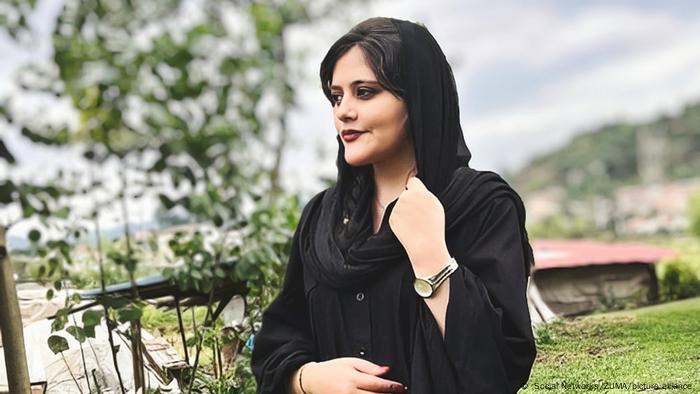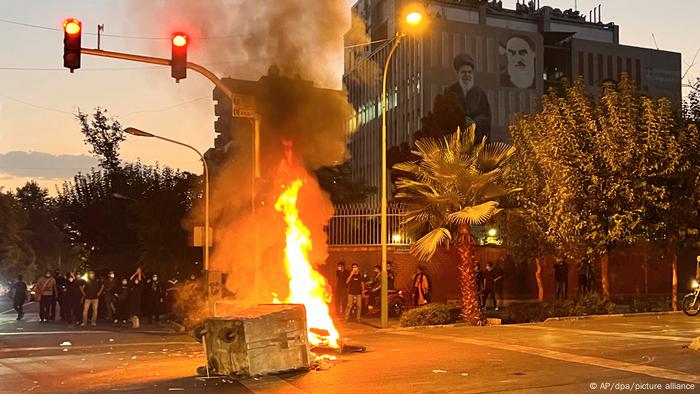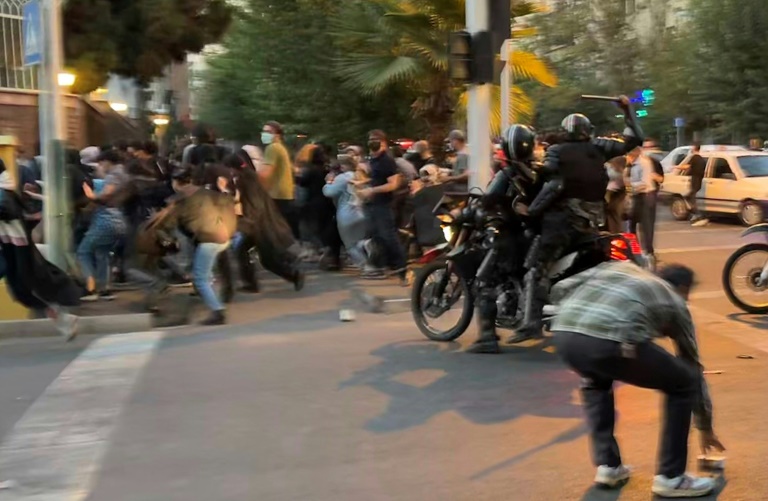SHIA WAR ON KURDISTAN
Iran hijab protests: Young woman's death puts Tehran under pressure
Mass protests have broken out across the Islamic nation amid public rage over the death of a young woman who had been arrested by the "morality police."

Mahsa Amini's death triggered mass protests and discussions over the compulsory
wearing of the Islamic headscarf in Iran
The recent death of a young woman who had been detained by Iran's "morality police" for violating the Islamic nation's conservative dress code has sparked mass protests across the country.
Mahsa Amini, 22, died last week after she was arrested for allegedly not complying with strict rules on head coverings for women.
Iran's President Ebrahim Raisi, who departed for New York on Monday to address the UN General Assembly, has ordered an investigation and vowed to pursue the case in a phone call with Amini's family. He also offered his condolences, the state-run IRNA news agency reported. "Your daughter was like my daughter," the president reportedly said.
Widespread anger and grief
The incident has caused outrage and grief in Iran and across the globe.
The hashtag #MahsaAmini has been trending on social media platforms such as Twitter and Instagram.
Mass protests flared up in Amini's home province of Kurdistan and other parts of the country. In the capital, Tehran, thousands of people took to the streets to express their anger and grief, chanting slogans such as "Death to the dictator."
Security forces tried to disperse the crowds using water cannon and batons.
Some protesters were also arrested, Iran's Fars news agency reported.
Media outlets worldwide have reported extensively about it.
When Iran's president meets with journalists on the sidelines of the UN General Assembly, as planned, the death of Mahsa Amini will dominate the press conference
The Iranian government has come under increasing pressure to carry out a proper and transparent investigation and bring the culprits to justice.
A spokesperson for EU foreign policy chief Josep Borrell called for those responsible for Amini's death to be held accountable and for the fundamental rights of all people in Iran to be protected — including those of prisoners.
Human Rights Watch demanded the abolition of the morality police and religiously based laws such as those on the proper wearing of headscarves.
A tragic end
The 22-year old from the small town of Saghes in the western province of Kurdistan had been on a visit to Tehran with her brother last week.
She was arrested by the authorities last Tuesday, for allegedly not covering her hair with the Islamic headscarf, known as hijab, which is mandatory for Iranian women.
Just a couple of hours after her arrest, she was hospitalized.
Police said on Thursday that Amini was taken to a hospital after she allegedly had a heart attack while in custody.
They have denied the allegations that she was physically abused after her arrest, saying "there was no physical encounter" between officers and Amini.
On closed-circuit footage — also released by police — Amini can be seen falling over after getting up from her seat to speak to an official at a police station. She is then shown being carried away on a stretcher.
Her family says she had no history of heart trouble.
A photo that went viral on the internet shows the bedridden Amini with swollen black eyes and bleeding ears. Many Iranian women, both young and old, could relate to it as they face daily humiliation and abuse in the hands of authorities because of the mandatory hijab.
Amini was officially declared dead on Friday, three days after she was admitted to the hospital. The Kasra Hospital, where Amini was admitted, said in a statement on Instagram on Saturday that the patient had been brain-dead on arrival. The statement was later deleted.
Opposing the compulsory hijab
The hijab has been compulsory for women in Iran since the 1979 Islamic Revolution, and the morality police are charged with enforcing that and other restrictions. The force has been criticized in recent years, especially for its treatment of young women.
Millions of Iranian women oppose the rules. In recent years the protests have become increasingly louder and more visible.
Many women wear their headscarves loosely and let them fall onto their shoulders, accepting the risk of being arrested.
The government under Raisi and religious hard-liners in parliament have been trying for months to enforce Islamic laws more strictly.
Numerous videos are currently circulating on the internet, showing women being beaten and abused by the authorities during arrests. The videos often show violent blows to the head as the women are dragged into the police car by their hair.

Mass protests flared up not only in Amini's home province of Kurdistan
but also in other parts of the country
Doubts over investigation
State media reported that authorities had opened an investigation to determine the cause of the death. The judiciary has launched a probe, and a parliamentary committee is also looking into the incident.
But many Iranians doubt that the probe will be carried out in an objective and transparent manner.
Amini's body, which was transported to her hometown of Saghes without an autopsy, was buried on Saturday morning.
Protests over the death began on the same day in her home province.
At the funeral, thousands demonstrated in front of the governor's office. According to the Fars news agency, clashes with security forces also occurred. Police used tear gas to disperse the crowds.
Security forces intervened during demonstrations in Sanandash, the capital of the Kurdistan province, on Sunday evening. Warning shots were fired, and several people were injured, reports from the province stated. A Kurdish human rights organization reported four deaths during the demonstrations.
In solidarity, businesses in Kurdistan announced that they would close their stores on Monday.
On Tuesday, the UN also decried Amini's death and called for the repeal of all discriminatory laws and regulations that impose mandatory hijab.
"Acting UN High Commissioner for Human Rights Nada Al-Nashif today expressed alarm at the death in custody of Mahsa Amini ... and the violent response by security forces to ensuing protests," the rights office said in a statement.
"The authorities must stop targeting, harassing and detaining women who do not abide by the hijab rules."
This article was originally published in German.
Concern mounts at ‘lethal’ Iran crackdown on protests
Paris – The United Nations and rights groups expressed concern Tuesday over what activists described as a lethal crackdown in Iran against protests over the death of a young woman after her arrest by Tehran’s notorious morality police.
Mahsa Amini, 22, died on Friday three days after she was urgently hospitalised following her arrest by police responsible for enforcing Iran’s strict dress code for women.
Activists said she suffered a blow to the head in custody but this has not been confirmed by the Iranian authorities, who have opened an investigation.
There have been protests in Tehran but the fiercest clashes so far have been in Iran’s northern Kurdistan province where Amini was from, with rights groups saying up to four protesters have been killed so far and dozens more wounded and arrested.
New York-based Human Rights Watch said that witness accounts and videos circulating on social media “indicate that authorities are using teargas to disperse protesters and have apparently used lethal force in Kurdistan province.”
“Cracking down with teargas and lethal force against protesters demanding accountability for a woman’s death in police custody reinforces the systematic nature of government rights abuses and impunity,” said Tara Sepehri Far, HRW’s senior Iran researcher.
In Geneva, the UN said acting High Commissioner for Human Rights Nada Al-Nashif expressed alarm at Amini’s death and the “the violent response by security forces to ensuing protests.”
She said there must be an independent investigation into “Mahsa Amini’s tragic death and allegations of torture and ill-treatment.”
– ‘Stop further state killings’ –
The Kurdish human rights group Hengaw, which is based in Norway, said it had confirmed a total of three deaths in Kurdistan province — one apiece in the towns of Divandareh, Saqqez and Dehglan.
It added that 221 people had been wounded and another 250 arrested in the Kurdistan region, where there had also been a general strike on Monday.
A 10-year-old girl — images of whose blood-spattered body have gone viral on social media — was wounded in the town of Bukan but was alive, it added.
Images posted on social media have shown fierce clashes especially in the town of Divandareh between protesters and the security forces, with sounds of live fire.
The Oslo-based Iran Human Rights (IHR) group said that four people had been killed in protests where people shouted slogans including “Death to the dictator” and “Woman, life, freedom”.
“The international community shouldn’t be silent observers of the crimes the Islamic Republic commits against its own people,” said IHR director Mahmood Amiry-Moghaddam.
“We call on countries with diplomatic relations with Iran, the EU in particular, to stop further state killings by supporting the people’s demands to realise their basic rights.”
IHR said security forces used batons, teargas, water cannons, rubber bullets and live ammunition in certain regions “to directly target protesters and crush the protests.”
The UN statement said at least two people have reportedly been killed and several injured.
– ‘Systemic persecution’ –
The death of Amini has caused international consternation, with US Secretary of State Antony Blinken calling Monday “on the Iranian government to end its systemic persecution of women and to allow peaceful protest.”
The Islamic headscarf has been obligatory in public for all women in Iran since shortly after the 1979 Islamic revolution that ousted the shah.
The rules are enforced by a special unit of police known as the Gasht-e Ershad (guidance patrol), who have the power to arrest women deemed to have violated the dress code, although normally they are released with a warning.
In rare published criticism from within Iran, Jalal Rashidi Koochi, a member of parliament, told the ISNA news agency that “Gasht-e Ershad is wrong because it has had no result except loss and damage for the country,” adding that “the main problem is that some people resist accepting the truth.”
Iran’s President Ebrahim Raisi plans to travel to New York for the UN General Assembly this week where he is set to face intense scrutiny over Iran’s human rights record.
French President Emmanuel Macron is to hold a rare meeting with Raisi later Tuesday in a final attempt to agree a deal reviving the 2015 nuclear accord.
Issued on: 20/09/2022 -
A top United Nations official on Tuesday demanded an independent investigation into the death of an Iranian woman held by the country's morality police as authorities acknowledged making arrests at protests over the incident.
The woman's death has ignited demonstrations across the country, including the capital, Tehran, where demonstrators chanted against the government and clashed with police.
The U.N. Human Rights Office said Iran's morality police have expanded their patrols in recent months, targeting women for not properly wearing the Islamic headscarf, known as hijab. It said verified videos show women being slapped in the face, struck with batons and thrown into police vans for wearing the hijab too loosely.
A similar patrol detained 22-year-old Mahsa Amini last Tuesday, taking her to a police station where she collapsed. She died three days later. Iranian police have denied mistreating Amini and say she died of a heart attack. Authorities say they are investigating the incident.
“Mahsa Amini’s tragic death and allegations of torture and ill-treatment must be promptly, impartially and effectively investigated by an independent competent authority,” said Nada Al-Nashif, the acting U.N. high commissioner for human rights.
Iran's government did not immediately comment on the statement but has previously criticized the work of U.N. investigators examining rights issues in the country.
The police released closed-circuit video footage last week purportedly showing the moment Amini collapsed. But her family says she had no history of heart trouble.
Amjad Amini, her father, told an Iranian news website that witnesses saw her being shoved into a police car.
“I asked for access to (videos) from cameras inside the car as well as courtyard of the police station, but they gave no answer,” he said. He also accused the police of not transferring her to the hospital promptly enough, saying she could have been resuscitated.
He said that when he arrived at the hospital he was not allowed to view the body, but managed to get a glimpse of bruising on her foot.
Authorities then pressured him to bury her at night, apparently to reduce the likelihood of protests, but Amini said the family convinced them to let them bury her at 8 a.m. instead.
Amini, who was Kurdish, was buried Saturday in her home city of Saqez in western Iran. Protests erupted there after her funeral and police fired tear gas to disperse demonstrators on Saturday and Sunday. Several protesters were arrested.
The protests spread to Tehran and other cities on Monday. A news website affiliated with state TV said 22 people were arrested at a protest in the northern city of Rasht, the first official confirmation of arrests related to the protests.
State TV showed footage of protests on Monday, including images of two police cars with their windows smashed. It said the protesters torched two motorbikes as well, and that they burned Iranian flags in Kurdish areas and Tehran.
The state-run broadcaster blamed the unrest on foreign countries and exiled opposition groups, accusing them of using Amini's death as a pretext for more economic sanctions.
Iran has seen waves of protests in recent years, mainly over a long-running economic crisis exacerbated by Western sanctions linked to the country's nuclear program. Authorities have managed to quash the protests by force.
(AP)


No comments:
Post a Comment